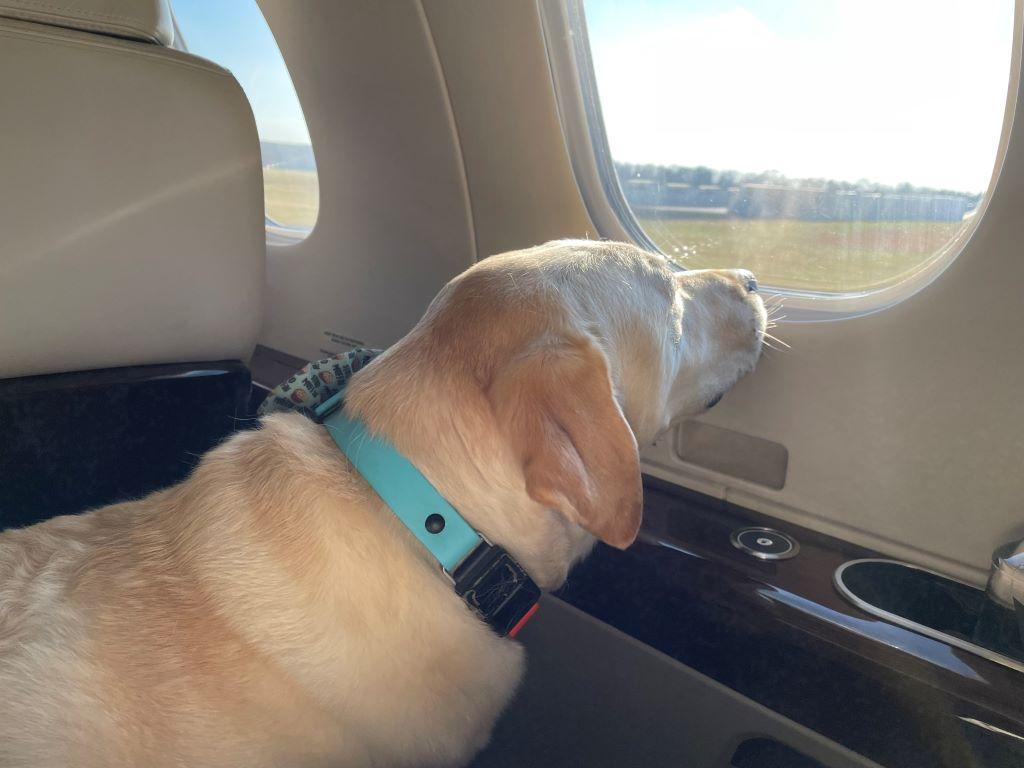Opinion: Pets In The Cockpit And On Ramp

Private jets are pet-friendly but beware of the risks of fluffy friends.
Unlike the airlines, most private air carriers allow pets of any size as long as they are leashed or in a pet carrier. Passengers may need to pay a pet fee, or simply bear the cost of any cleanup or repairs needed after a flight if there are any accidents or excessive shedding left behind.
“Once flew a tiger. Had a special cage made for the airplane and a vet with a tranquilizer gun rode in the right seat in case Mike, err, the tiger, woke up.” – Private Jet Pilot
While most passengers generally follow the rules of keeping pets secured during flight, there are occasional escapees that can be entertaining. While they seem cute at first, pilots should demand passengers keep their pets secured not only for the safety of the flight but for the safety of the pet as well.
“Flew one client who brought two very friendly cats on board. They made for great company in the cockpit, but they decided that the nook behind the rudder pedals was a good place to hide on descent. We managed to wrangle them into their carriers before landing, but probably should have done so earlier.”- Private Jet Pilot
In the FAA’s ASIAS (Aviation Safety Information Analysis and Sharing) system database, a fractional pilot reported, “During our initial descent…we encountered severe, borderline extreme turbulence…We had one passenger traveling with a (cat). The cat was out of the carrier laying on the seat beside the passenger and went airborne. The cat did not seem to suffer any injuries.”
This cat happened to have nine lives, but in other reports, unrestrained pets can suffer deadly injuries from turbulence.
Private passengers carrying larger dogs should bring harnesses, tethering systems and arrive early to plan with the flight crew, mindful that most private jet seatbelts are not compatible with car harnesses.
Look for tethers that attach to a belt, and aren’t inserted into a buckle. Those with smaller pets that can fit in carriers are more easily tethered to seats--passengers may open the carrier during flight, provided the pet is tethered to the carrier.
Larger dogs seem to be more frequent violators of safety rules.
An undisclosed charter pilot reported: “At an altitude of 5,000FT MSL, one of the (4) Golden Retrievers on board made his way to the cockpit and put one paw on the engine ignition panel and with (his) other paw moved the thrust levers into odd detent settings.”
Part 135 and fractional operators seem to have lower dog-incident reports, while Part 91 pilots have reported more trouble in the cockpit, including: “lost directional control and struck snowbank when dog jumped on lap during rollout.” And: “[Pilot] said that he was distracted by a dog that got free of restraints and attempted to enter the cockpit. The pilot said that he attempted to land with the extra speed and the aircraft porpoised.”
‘Dog on Ground’ incidents are equally as wild, with one GA pilot reporting his Piper Super Cub “was running at idle with a dog in the baggage area when the operator realized he forgot to lock his truck and grab his keys. When the operator got out to lock his truck, the dog jumped forward into the backseat and knocked the throttle control forward and the plane ground taxied into a parked plane across the ramp.”
Dog strikes on the runway are found in countless reports and far outnumber any in-aircraft emergencies.
At smaller airports frequented by Part 135 and fractional operations, security controls are less rigorous and the possibility of a hangar-dog or loose passenger pet ending up on the runway is more likely than at large, international airports.
At a small airport in the Midwest, a pilot who already had a near-miss on the runway with a dog claimed: “No more than an hour later, another woman came out to walk her dog. too. I told her about the near-miss earlier, it did not seem to phase her. She said they have been doing it for years, and her dog needed to run.”
Conversely, some over-zealous airport security guards at an airport in Hawaii once fired a shotgun towards an aircraft in an attempt to kill dogs that had wandered onto the airport.
Pets can be wonderful flying companions, but pilots should remain vigilant for unrestrained animals on the ground and in the air, and firm with their passengers on safety securing them during flight.
A loose pet could make for an entertaining story, at best, but could easily spiral into a dangerous situation.
Jessie Naor is COO of GrandView Aviation, a Part 135 charter operator. She currently serves on the executive committee of the Air Charter Safety Foundation and is vice-chair of the National Air Transportation Association’s Part 135 committee. Jessie has participated in FAA rulemaking committees and has received the NBAA’s Top 40 Under 40 Award in 2020.




